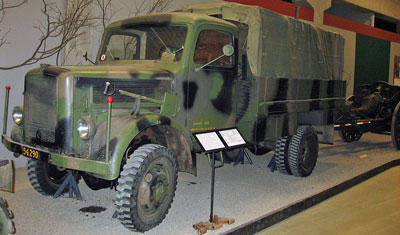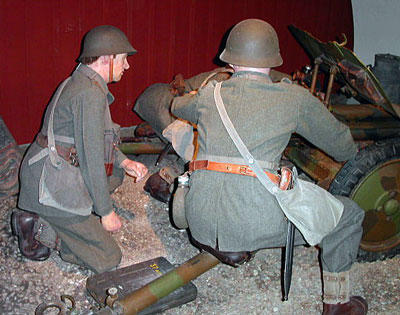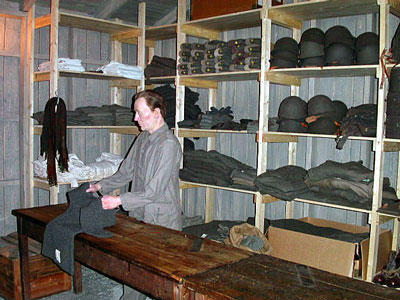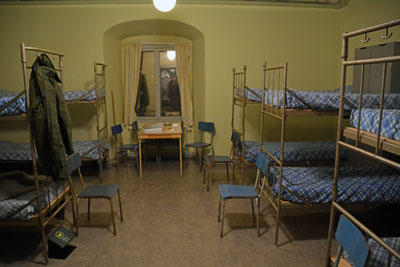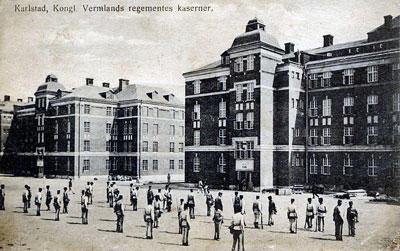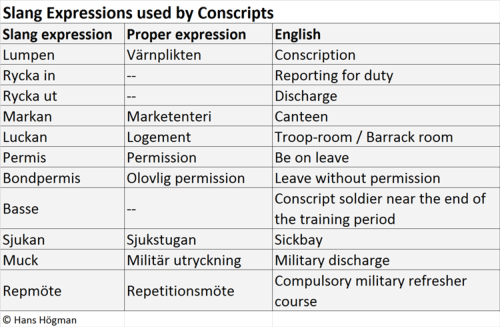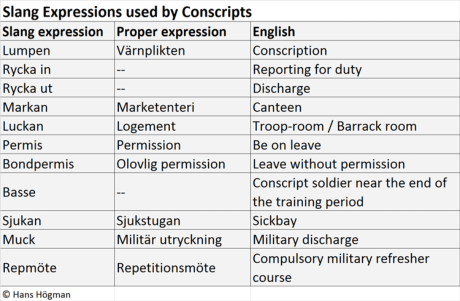

Copyright © Hans Högman 2021-01-11
The Organization of the
Swedish Armed Forces
during the Conscription
Period 1901 - 2010
Introduction
Sweden had a military system entirely based on a
Universal National Military Service called Allmän
Värnplikt (Universal Conscription) between 1901 and
2010.
The term "Allmän Värnplikt" literally means "Universal
duty to defend (your country)". [Allmän = universal.
Värnplikt is a compound word consisting of "värn"
and "plikt". "Värn" is derived from "värna" which
means defend and "plikt" means duty.].
The system was a compulsory military service. Each
year, a fixed number of new recruits were drafted for
military training. When one set of recruits finished
their training period a new set of recruits was
drafted. Every able-bodied Swede at the age of 18
(first 21, then 20, later 18 years old) were liable to
undergo military training (military service).
Therefore young men were required to register to be
drafted for military service. The year they became of
draft age they were called-up for registration
(enrollment) in the National Service (mönstring).
The image to the right is the All-terrain truck m/42
(terrängbil m/42 M) used by the Swedish Army
(mostly the Artillery). It was delivered to the Army in
1943. Museum
Arsenalen. Photo: Hans
Högman, 2012.
The men approved for
military service were
assigned to a branch of
the Army (infantry,
cavalry, artillery, fortification etc.), the Air Force or the
Navy. Normally a draftee was called up into the
military service the same year he was
mustered/enrolled. The military service was a military
training period which was carried out at the assigned
regiment. The military training consisted of a basic
training period for about 360 days (the duration
depended of the service posting and has varied over
the years) followed by three compulsory military
refresher courses (repetitionsövning) of 30 days each.
The Conscript System
Sweden had a conscript system until 2010 when it
was replaced with an all-volunteer system with
soldiers on a contractual employment for shorter or
longer terms.
During the Conscription period (1901 – 2010) Sweden
had two type of military organizations:
•
The peacetime organization (Training) -
[Fredsorganisationen]
•
The war organization [Krigsorganisationen]
The peacetime organization was small and in
numbers only 10 to 15% of the war organization.
The peacetime organization’s main purpose was to
train new soldiers for the armed forces (the war
organization). The war organization was of course the
armed forces to be used in war. The war organization
was also responsible for the compulsory refresher
courses which were warlike exercises with the
different units, manned by conscripts.
The image to the right is
showing conscript
soldiers in emergency
services during WWII.
The soldiers are wearing
uniform m/1939.
Display at the Army
Museum, Stockholm.
Photo: Hans Högman,
2003.
Not only did the peacetime organization produce
rank and file soldiers with the rank of Private,
conscript NCOs and Officers were also produced.
A conscript Officer could reach the rank of an army
Captain. Under the war organization regular NCOs
and Officers up to the rank of Captain constituted
only about 10% of all NCOs and Officers. Conscript
NCOs and Officers accounted for the rest.
Every year young man, at the age of 20, was
registered for military service and called up for the
basic training. Every year an age group was military
trained. When they were discharged from the basic
training each draftee was assigned a wartime posting
(krigsplacering) in the war organization.
The annual age group called up for military training
also constituted the alert force in case of a military
emergency. In case of war the wartime organization
was activated by a general mobilization order of all
draftee soldiers. The mobilization process was tested
every time the draftees were called up for the
compulsory refresher courses. They were called up in
a wartime manner through a partial mobilization
exercise.
The mobilization process was very “tuned up” and the
war organization was able to be on war foot after
only three days. However, the entire armed forces
weren’t fully operational until after 14 days.
Mobilization
The soldiers in the war organization only existed in
“the registers” in peacetime. The war organization
was activated via a mobilization and manned by the
draftees that had passed the basic training and been
given a wartime posting. A mobilization could be
triggered at danger of war or a military conflict or by
a war exercise (the refresher courses).
Mobilization is the act of assembling and making
both troops and supplies ready for war.
When the draftees were discharged after the basic
training they were, as mentioned above, assigned a
wartime posting. This was documented in the “war
posting card” (krigsplacering). This card was mailed to
each discharged draftee when they had completed
their basic training.
The card specified where the draftee was to report
for duty in case of war. More specifically it indicated
which mobilization depot the draftee had to report to
– to be equipped with uniform, arms etc. Once
equipped, the draftee was to join the unit he was
assigned to.
The image to the
right is showing a
WWII mobilization
depot. Display at the
Army Museum,
Stockholm. Photo:
Hans Högman, 2003.
The armed forces had thousands and thousands of
secret mobilization depots (supply depots)
[Mobiliseringsförråd] all around the country, mostly in
the countryside. These depots were filled with
supplies needed for the war organization in case of
war.
When a draftee received the mobilization order he
immediately had to go to “his” mobilization depot to
be dressed in uniform and armed and there join his
war unit. Once manned each unit were to take up
position at a predetermined spot and there wait for
further orders.
The mobilization was safeguarded by the Swedish
National Home Guards (Hemvärnet) since they were
operational within hours. The Home Guard soldiers
had their military equipment at home. They were
therefore able to keep a high military preparedness.
The National Home Guards were in charge of the
local defence until the regular Army took over.
According to the regulations - once a general
mobilization order was issued by the Swedish
authorities the mobilization could not be
terminated. There was a reason for this:
Disinformation from an enemy state mustn’t stop a
Swedish mobilization.
During the Cold War Swedish citizens were drilled
with the motto “Every message that the mobilization is
terminated is FALSE.” ("Varje meddelande om att
mobiliseringen skall avbrytas är FALSKT.").
Until the end of the 1980’s the Swedish telephone
directory contained a section titled “In Case of War”
(Om Kriget Kommer). This section instructed Swedish
citizens what to do in case of mobilization and war. In
the section it was clearly stated “Every message that
the mobilization is terminated is FALSE!”.
There was a second slogan too: “Every statement that
the resistance has ceased is FALSE!” ("Varje meddelande
att motståndet skall uppges är falskt!"). This slogan
means that the fighting troops and any resistance
movements (in case of enemy occupation) were not
to believe such FALSE messages. Troops and
members of the Resistance must not cease fire or
give up. They must keep on fighting the enemy.
During WWII there was a vigilance campaign called
“En Svensk Tiger” (A Swedish Tiger). The Swedish
word “tiger” has two meanings
depending upon context. The
first meaning is the big cat
Tiger we are all familiar with.
The second meaning meant
“Keep Silent” to the Swedish
people. A picture of a drawn tiger in the Swedish flag
colors, yellow and blue, was the symbol of the
Swedish vigilance campaign. “En Svensk Tiger” was
both the slogan and the image of the Swedish
espionage prevention programs by encouraging
secrecy.
The purpose of the campaign was to get people
aware of the risk of unintentionally spreading military
information to enemy agents by talking to other
Swedes in public places on the topic. So, the message
was "keep silent about military information". The
poster had the mixed meaning "a Swedish tiger" or "a
Swede keeps silent".
There was another slogan “Fienden lägger pussel”
which literally means “The Enemy Does Jigsaw
Puzzles.” The slogan implied that enemy agents
would put different small pieces of information
together to be able to assemble the big picture.
There was a similar campaign in the USA during WWII
using the slogan “Loose Lips Sink Ships!”
The Peacetime Organization -
Barracks
In the 1800s the conscripts were trained during the
summer months only. The military training was held
on the different regiments' training grounds. Since
the training period was during summers the
conscripts slept under canvas. At the end of the
1800s simple barracks were built at the training
grounds for the lodging of the conscripts.
In 1901 when Sweden switched to a Universal
Conscription System with an armed force entirely
built on draftees the duration of the training period
was largely extended. The draftees were to be trained
year-round, including winters. The Swedish winters
can be very cold with lots of snow which demanded
proper barracks. Barracks were built in the garrison
towns, a massive building project that took some
time to complete.
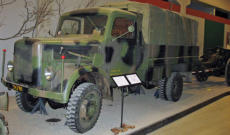
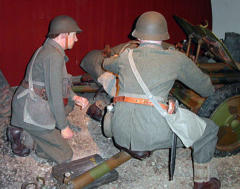

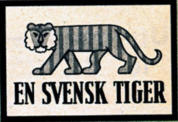
The image shows a typical troop-room (logement) in
a barrack (kasern) from the 1960s - 1970s. Note the
bunk beds.
Display at the Army Museum, Stockholm.
The image shows a typical troop-room (logement)
in a barrack (kasern) from the 1960s - 1970s.
Note the bunk beds.
Display at the Army Museum, Stockholm.
The image shows some of the Värmland
Regiment's barracks, Karlstad city, Värmland,
1920s.
Free image Wikipedia.
Slang Expressions used by
Conscripts







